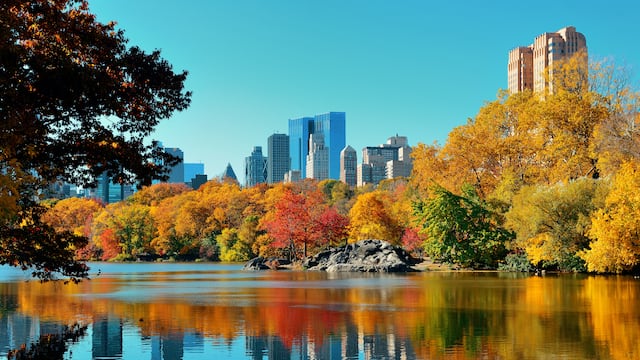Every fall across the nation, Mother Nature paints the landscape in an array of vibrant colors leaving one awestruck. But what causes the transformation?

Why do leaves change color in the fall?
While not everyone may be the outdoorsy type, it is hard not to be awestruck by the vibrantly painted landscape that nature displays for us every autumn. The seasonal masterpiece draws our attention due to the breathtaking palette of hues that the foliage acquire.
While fall colors indicate that the days are getting colder, and the nights even more so, the warm tones of orange, red and yellow make the adieu to the summer months a more pleasant affair. But what causes trees and shrubs to transform their leaves from verdant green into this splendid multicolored masterpiece?
Why do leaves change color in the fall?
There are still some aspects of the process that scientists have yet to figure out to fully explain what is happening and why within the leaves as they change color. But enough is known to share the basics behind the transformation.
According to the US Forest Service there are three main factors that influence the biochemical reaction taking place. These include the pigments in the leaves, the amount of daylight and weather conditions.
Six years ago today I was in Ohiopyle to capture some of the fall colors, and it could not have been a more perfect day to visit. The color was at peak, and though some leaves had fallen off the trees, they were still plenty full making for beautiful fall scenes. pic.twitter.com/3ahmThGo78
— Dave DiCello (@DaveDiCello) October 23, 2025
The primary trigger for the leaves’ transformation is the increasing length nights in autumn and the shortening of the days. This means less sunlight for the leaves to produce chlorophyll, the biochemical compound that gives them their vivid green color. As production of chlorophyll slows, eventually stopping and breaking down, other compounds present in the leaves are able to stand out.
These include carotenoids and flavonoids, which are present in foliage throughout the year but are overwhelmed by high amounts of chlorophyll during the summer months. There are types of compunds of both that are responsible for the yellows we see.
Certain carotenoids like beta-carotene are responsible for the orange color in autumn leaves, others can create scarlet reds.
Collection of pics of Fall Colors / Autumn leaves taken in my neck of woods. Enjoy!
— Rajendra Marathe (@marathe) November 15, 2025
4/4 pic.twitter.com/TB1pPKtftt
A type of flavonoid, anthocyanin, produces deep reds and purples. However, this particular compound isn’t always present in leaves during the summer months. These show their colors when sugars get trapped in the foliage as the veins connecting the leaf to the tree gradually close off as a layer of cells forms at the base.
The buildup of sugar promotes the development of anthocyanins, which is thought to perhaps help protect the leaf from the sunlight in its final days before it is completely sealed off from the tree and falls to the ground.
The Pennsy Trail is full of color right now, and the last of the fall leaves are putting on a beautiful show. Indy has so many incredible paths to explore, and this is one of them! 🍁🍂 pic.twitter.com/C2ud8SIUvA
— Indy Department of Public Works (@IndyDPW) November 18, 2025
What do weather conditions do for fall colors?
While the timing of when leaves will change their color cannot be precisely predicted, as mentioned, it is mainly dependent on the solar cycle. However, weather conditions play their part in the profusion and splendor of the autumnal landscape meaning that no two autumn landscapes are the ever the same.
The US Forest Service explains that the most breathtaking color displays are produced when there are “a succession of warm, sunny days and cool, crisp but not freezing nights.” These allow for the generous production of sugars in the leaves during the day, but the cool nights help slow the flow of the sugars leaving as the base of the leaves gradually close up leaving more pigments behind.
The stunning beauty of a field maple💛🧡🍁❤️💜
— Beatrice Groves (@beatricegroves1) November 4, 2025
In autumn, as the dominant chlorophyll breaks down, the riot of colour hidden by that green is revealed - the yellows and oranges of carotenoids💛🧡 along with the reds and purples of anthocyanins ❤️💜 pic.twitter.com/8I88zAZ27g
When is the best time to see fall colors?
Related stories
Don’t expect to nature to get all dressed up to coincide with your holiday booking to enjoy the spectacle based on the prediction you’ve made about when it will be at its prime. That shouldn’t deter you though from going out and enjoying nature in all its beauty following the over 100 Forest Service’s National Scenic Byways that have been planned with autumn color in mind.
Generally speaking though, the show gets under way beginning late September in New England. It will typically move gradually southward until reaching the Smoky Mountains around mid November.



Complete your personal details to comment